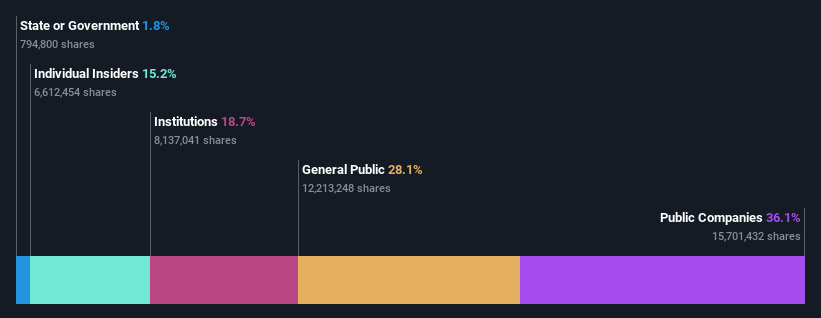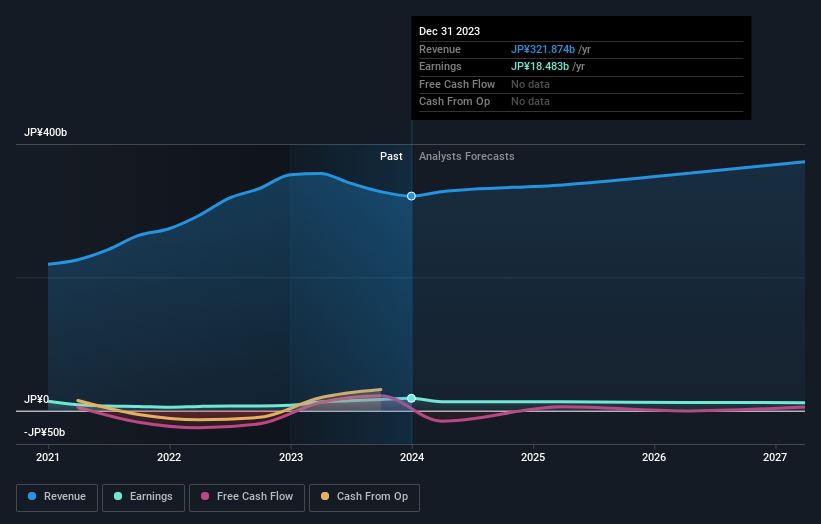Stock Analysis
- Japan
- /
- Metals and Mining
- /
- TSE:5440
Kyoei Steel Ltd.'s (TSE:5440) largest shareholders are public companies who were rewarded as market cap surged JP¥8.5b last week

Key Insights
- Kyoei Steel's significant public companies ownership suggests that the key decisions are influenced by shareholders from the larger public
- The top 6 shareholders own 51% of the company
- Insiders own 15% of Kyoei Steel
Every investor in Kyoei Steel Ltd. (TSE:5440) should be aware of the most powerful shareholder groups. We can see that public companies own the lion's share in the company with 36% ownership. In other words, the group stands to gain the most (or lose the most) from their investment into the company.
Clearly, public companies benefitted the most after the company's market cap rose by JP¥8.5b last week.
Let's delve deeper into each type of owner of Kyoei Steel, beginning with the chart below.
See our latest analysis for Kyoei Steel

What Does The Institutional Ownership Tell Us About Kyoei Steel?
Many institutions measure their performance against an index that approximates the local market. So they usually pay more attention to companies that are included in major indices.
Kyoei Steel already has institutions on the share registry. Indeed, they own a respectable stake in the company. This can indicate that the company has a certain degree of credibility in the investment community. However, it is best to be wary of relying on the supposed validation that comes with institutional investors. They too, get it wrong sometimes. If multiple institutions change their view on a stock at the same time, you could see the share price drop fast. It's therefore worth looking at Kyoei Steel's earnings history below. Of course, the future is what really matters.

Hedge funds don't have many shares in Kyoei Steel. Nippon Steel Corporation is currently the company's largest shareholder with 27% of shares outstanding. Hideichiro Takashima is the second largest shareholder owning 10% of common stock, and Akihiko Takashima holds about 5.1% of the company stock.
We also observed that the top 6 shareholders account for more than half of the share register, with a few smaller shareholders to balance the interests of the larger ones to a certain extent.
While it makes sense to study institutional ownership data for a company, it also makes sense to study analyst sentiments to know which way the wind is blowing. There are plenty of analysts covering the stock, so it might be worth seeing what they are forecasting, too.
Insider Ownership Of Kyoei Steel
The definition of company insiders can be subjective and does vary between jurisdictions. Our data reflects individual insiders, capturing board members at the very least. Company management run the business, but the CEO will answer to the board, even if he or she is a member of it.
Insider ownership is positive when it signals leadership are thinking like the true owners of the company. However, high insider ownership can also give immense power to a small group within the company. This can be negative in some circumstances.
It seems insiders own a significant proportion of Kyoei Steel Ltd.. It has a market capitalization of just JP¥111b, and insiders have JP¥17b worth of shares in their own names. It is great to see insiders so invested in the business. It might be worth checking if those insiders have been buying recently.
General Public Ownership
The general public-- including retail investors -- own 28% stake in the company, and hence can't easily be ignored. This size of ownership, while considerable, may not be enough to change company policy if the decision is not in sync with other large shareholders.
Public Company Ownership
It appears to us that public companies own 36% of Kyoei Steel. This may be a strategic interest and the two companies may have related business interests. It could be that they have de-merged. This holding is probably worth investigating further.
Next Steps:
It's always worth thinking about the different groups who own shares in a company. But to understand Kyoei Steel better, we need to consider many other factors. Like risks, for instance. Every company has them, and we've spotted 2 warning signs for Kyoei Steel (of which 1 can't be ignored!) you should know about.
Ultimately the future is most important. You can access this free report on analyst forecasts for the company.
NB: Figures in this article are calculated using data from the last twelve months, which refer to the 12-month period ending on the last date of the month the financial statement is dated. This may not be consistent with full year annual report figures.
Valuation is complex, but we're helping make it simple.
Find out whether Kyoei Steel is potentially over or undervalued by checking out our comprehensive analysis, which includes fair value estimates, risks and warnings, dividends, insider transactions and financial health.
View the Free AnalysisHave feedback on this article? Concerned about the content? Get in touch with us directly. Alternatively, email editorial-team (at) simplywallst.com.
This article by Simply Wall St is general in nature. We provide commentary based on historical data and analyst forecasts only using an unbiased methodology and our articles are not intended to be financial advice. It does not constitute a recommendation to buy or sell any stock, and does not take account of your objectives, or your financial situation. We aim to bring you long-term focused analysis driven by fundamental data. Note that our analysis may not factor in the latest price-sensitive company announcements or qualitative material. Simply Wall St has no position in any stocks mentioned.
About TSE:5440
Kyoei Steel
Kyoei Steel Ltd. engages in the manufacture, processing, and sale of billets and steel products in Japan, Vietnam, North America, and internationally.
Excellent balance sheet established dividend payer.

